MITSUBISHI GALANT 1989 Service Repair Manual
Manufacturer: MITSUBISHI, Model Year: 1989, Model line: GALANT, Model: MITSUBISHI GALANT 1989Pages: 1273, PDF Size: 37.62 MB
Page 271 of 1273
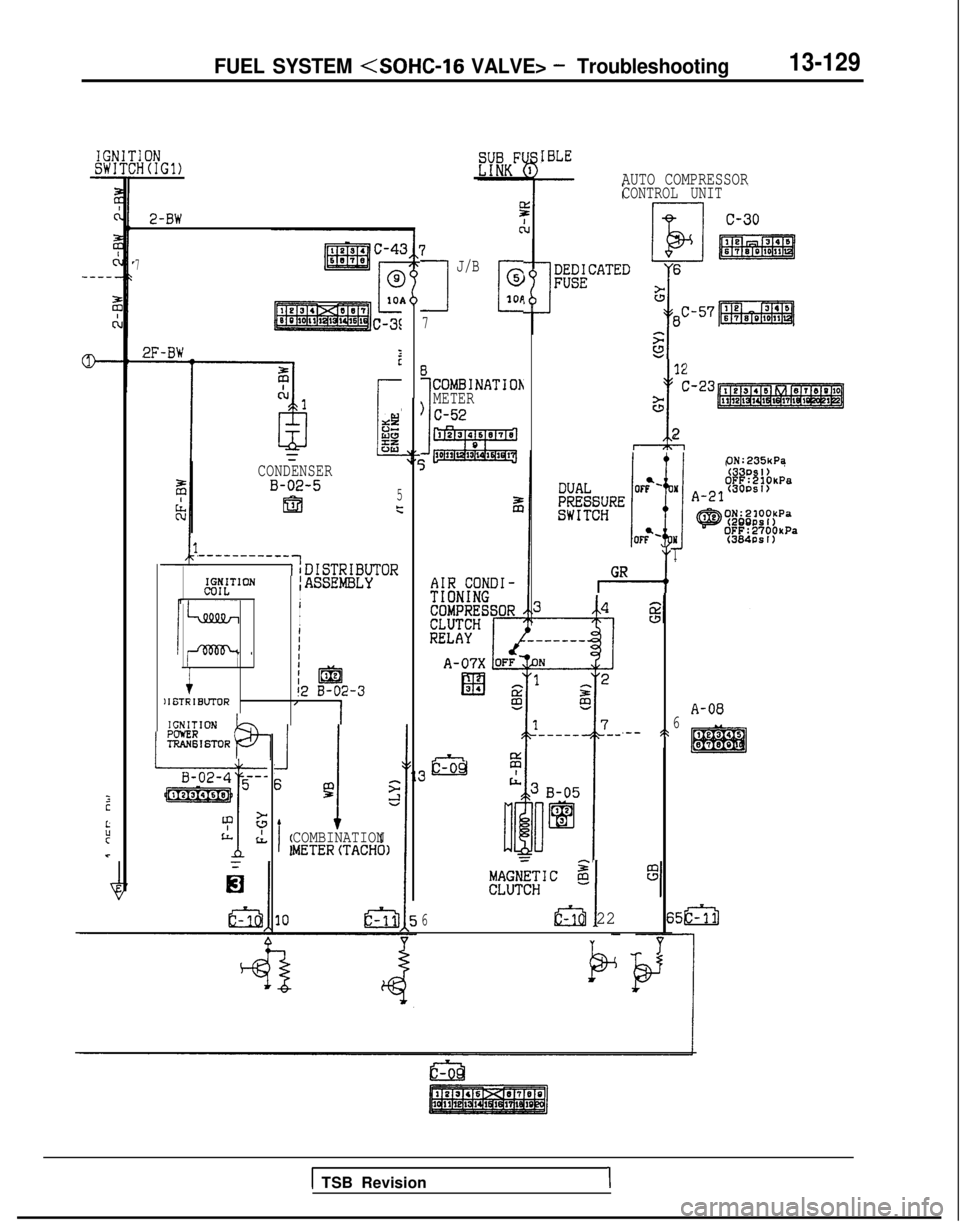
FUEL SYSTEM
'10N:H(IGl)
7
2F-BW
1
CONDENSERB-02-5
It!35e
----_-_--__
':DISTRIBUTORIGNITIONCOIL;ASSEMBLYrII
I
I
III
+I2 g&I
IGTR
I BUTOR,
IIGNITIONPOKERTFaN616TOR
B-02-4 5---jffj
T
In G
Lk
&COMBINATIONMETERtTACHO)
J/B
7 c
a 10R
7
8
1
COMBINATIOh
METER
) C-52
IBLE
AUTO COMPRESSORCONTROL UNIT
12
C-23
i
's
2
r-l
1
GR
6Ia 22
,--
ON:
235uPa
A-21
A-086,t
65m
1 TSB Revision1
Page 272 of 1273
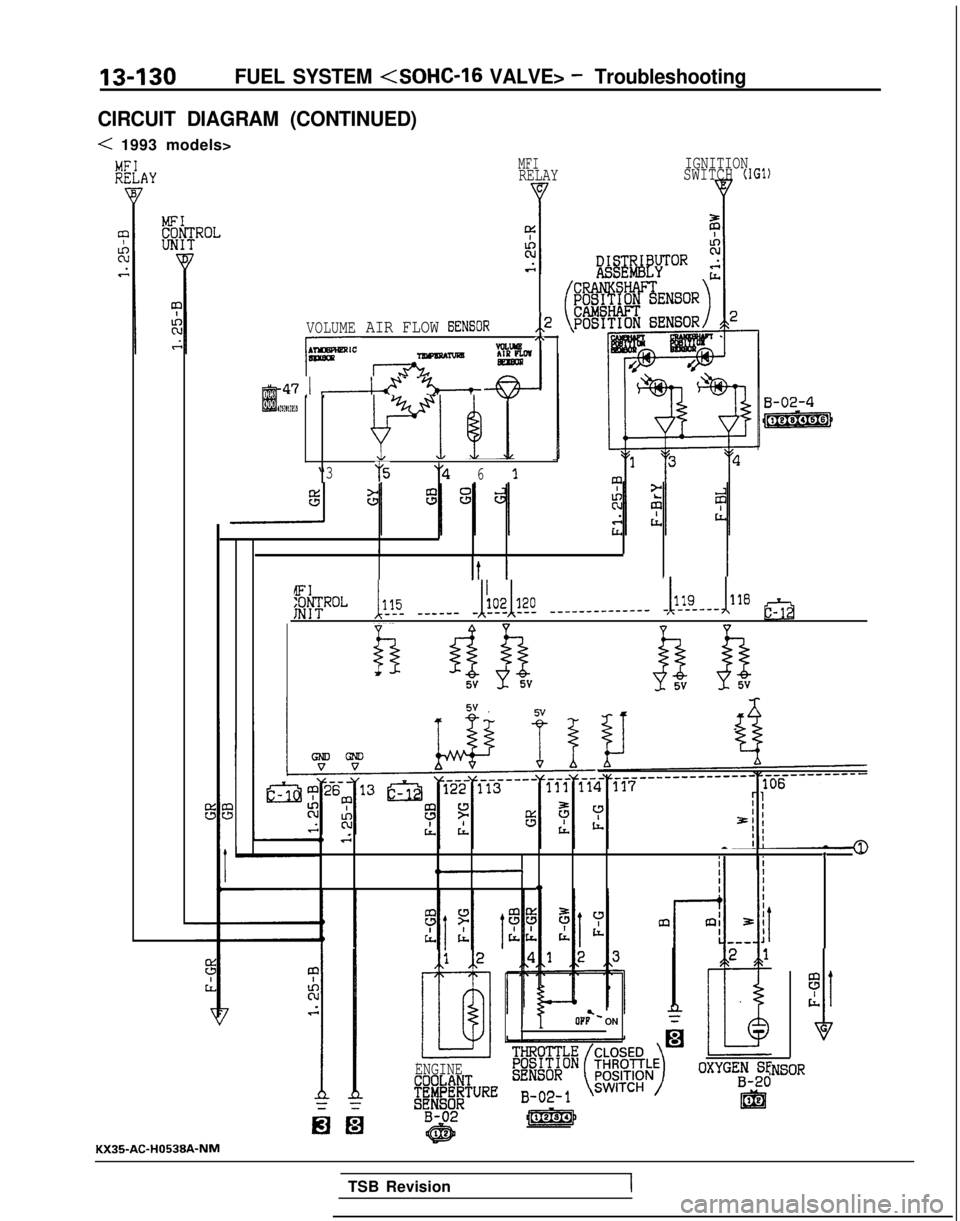
13-130FUEL SYSTEM
CIRCUIT DIAGRAM (CONTINUED)
< 1993 models>
VOLUME
A-47 1 &- -%--t
MFIRELAY IGNITIONSWITCH (IGl)
AIR FLOW EXNSOR,,2,\VCLLW7nwmAm
m 468 1ES 1
“375y461
1I
It II I
HFLb!. _-____ JLk? ______________ -bdl8 tQj
bui kk
B-02-4
m
0 .sT--q--
0
OF;- ONL
25
rl
I
1
G
ENGINE
#k&@"RE
:NSOR
KX35AC-H0538A-NM
TSB Revision
I
Page 273 of 1273
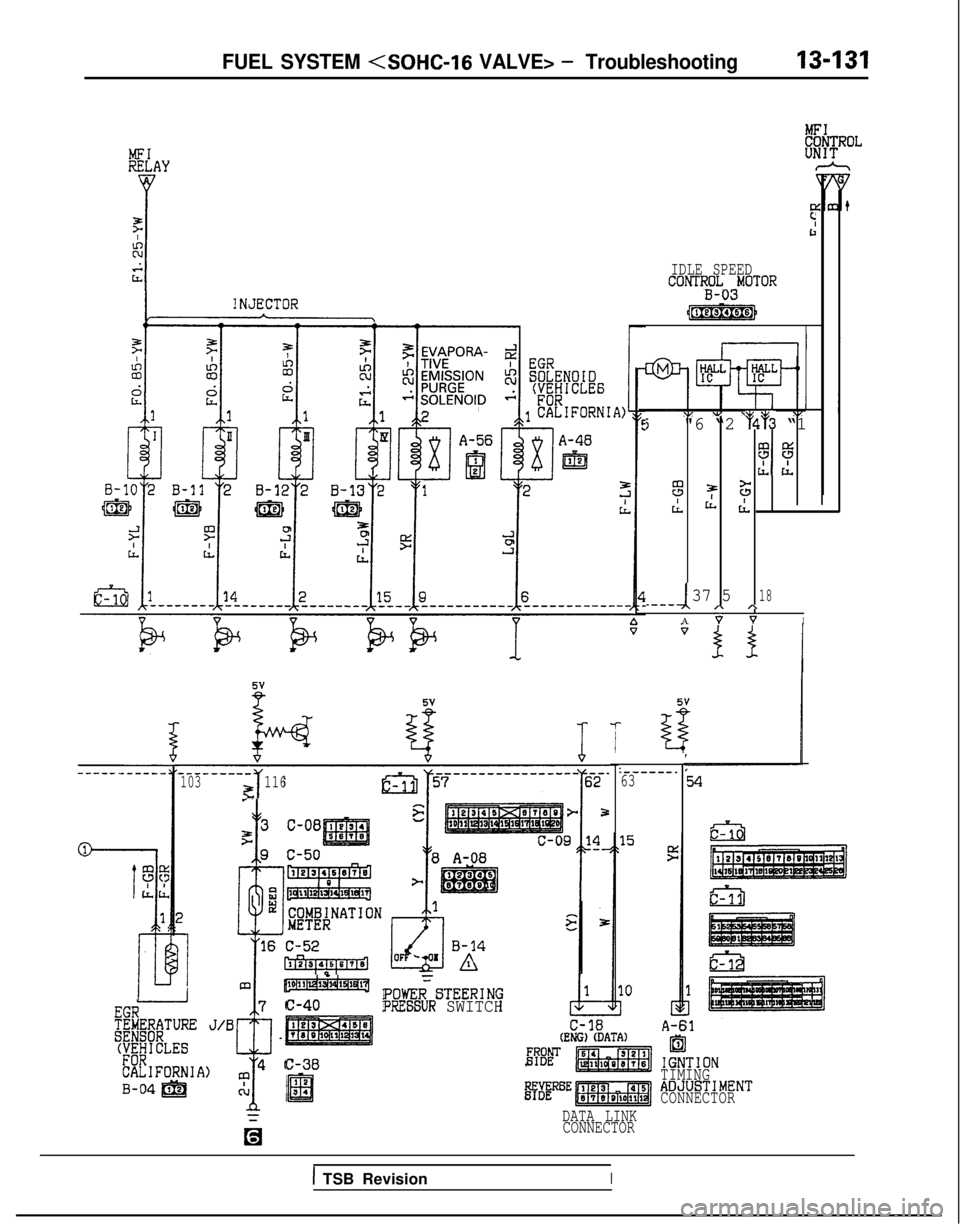
FUEL SYSTEM
z.
i
:
r:
R
E:IDLE SPEEDCONTROL -MOTORB-03(ii-G-q
\I .I \ w t,i"6 “2 "4"3 “1
EC3
LLrL
s
'f 5
LL LL rl
1 A /\37 518_---
Av vI
1
I
5%
LL,rl
2
1
E
---_----_103I2116
wij
c-40
C-381 2
Ei54
POWE&TEERINGPRESSUR SWITCH
C-38(EN’S) (DATA)
&T
DATA LINK
CONNECTOR
:------.63
I
IGNTIONTIMINGADJUSTIMENT
CONNECTOR
1 TSB RevisionI
Page 274 of 1273

13-132
NOTE
Page 275 of 1273
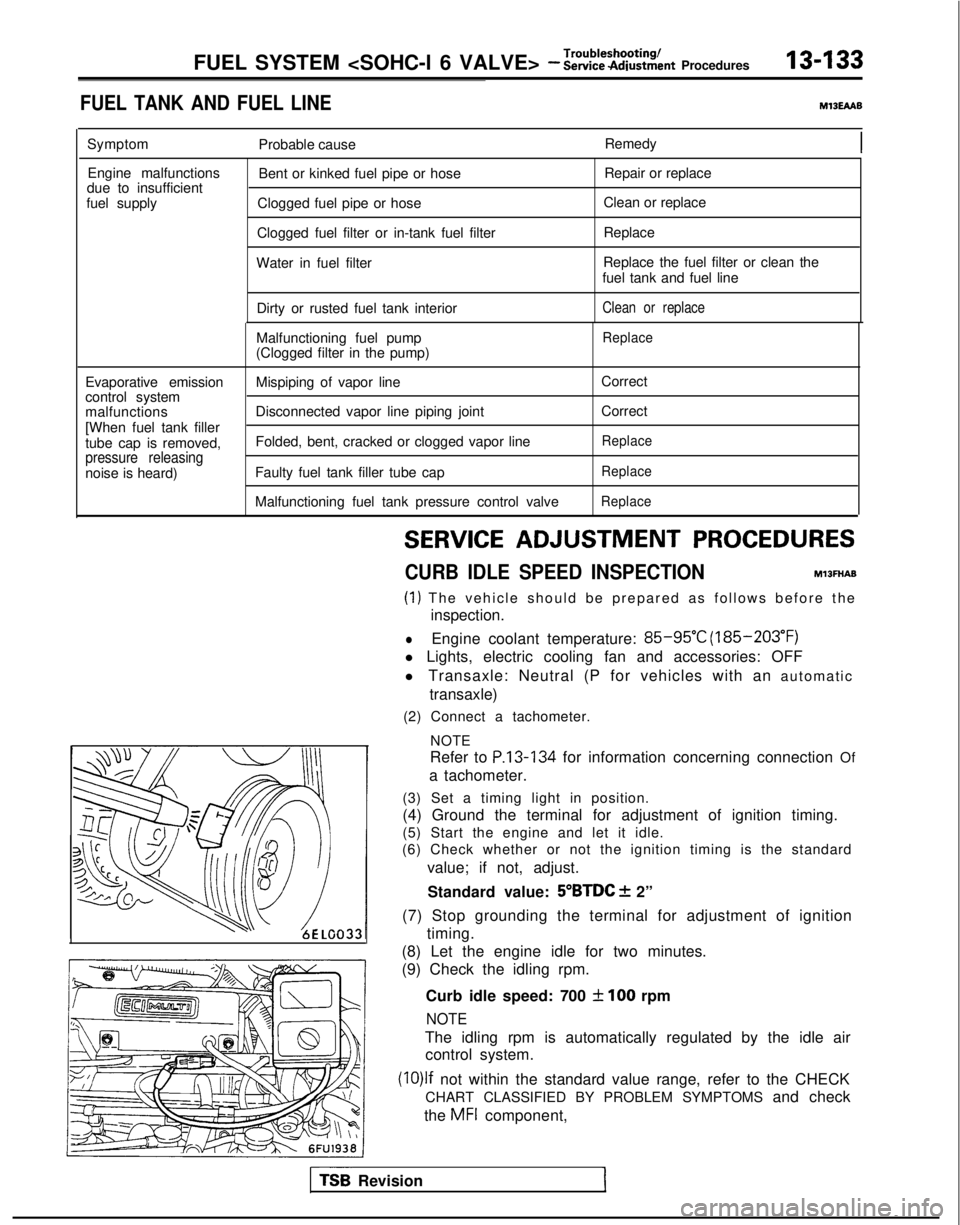
FUEL SYSTEM
FUEL TANK AND FUEL LINEMIBEAAB
Symptom
Probable cause Remedy
Engine malfunctions
due to insufficient
fuel supply Bent or kinked fuel pipe or hose
Clogged fuel pipe or hose
Clogged fuel filter or in-tank fuel filter
Water in fuel filter Repair or replace
Clean or replace
Replace
Replace the fuel filter or clean the
fuel tank and fuel line
Dirty or rusted fuel tank interior
Clean or replace
Malfunctioning fuel pump
(Clogged filter in the pump)Replace
Evaporative emission
control system
malfunctions
[When fuel tank filler
tube cap is removed,
pressure releasingnoise is heard) Mispiping of vapor line
Disconnected vapor line piping joint
Folded, bent, cracked or clogged vapor line
Faulty fuel tank filler tube cap
Malfunctioning fuel tank pressure control valve Correct
Correct
Replace
Replace
Replace
SERVICE ADJUSTMENT
PROCEDURES
CURB IDLE SPEED INSPECTIONhll3MAE
(1) The vehicle should be prepared as follows before th
e
inspection.
lEngine coolant temperature: 85-95°C (185-203°F)
l Lights, electric cooling fan and accessories: OFF
l Transaxle: Neutral (P for vehicles with an automatic
transaxle)
(2) Connect a tachometer.
NOTE
Refer to
P.13-134 for information concerning connection Of
a tachometer.
(3) Set a timing light in position.
(4) Ground the terminal for adjustment of ignition timing.
(5) Start the engine and let it idle.
(6) Check whether or not the ignition timing is the standard
value; if not, adjust.
Standard value:
5”BTDC f 2”
(7) Stop grounding the terminal for adjustment of ignition timing.
(8) Let the engine idle for two minutes.
(9) Check the idling rpm.
Curb idle speed: 700
31100 rpm
NOTE
The idling rpm is automatically regulated by the idle aircontrol system.
(lO)lf not within the standard value range, refer to the CHECK
CHART CLASSIFIED BY PROBLEM SYMPTOMS and check
the
MFI component,
TS6 Revision1
Page 276 of 1273
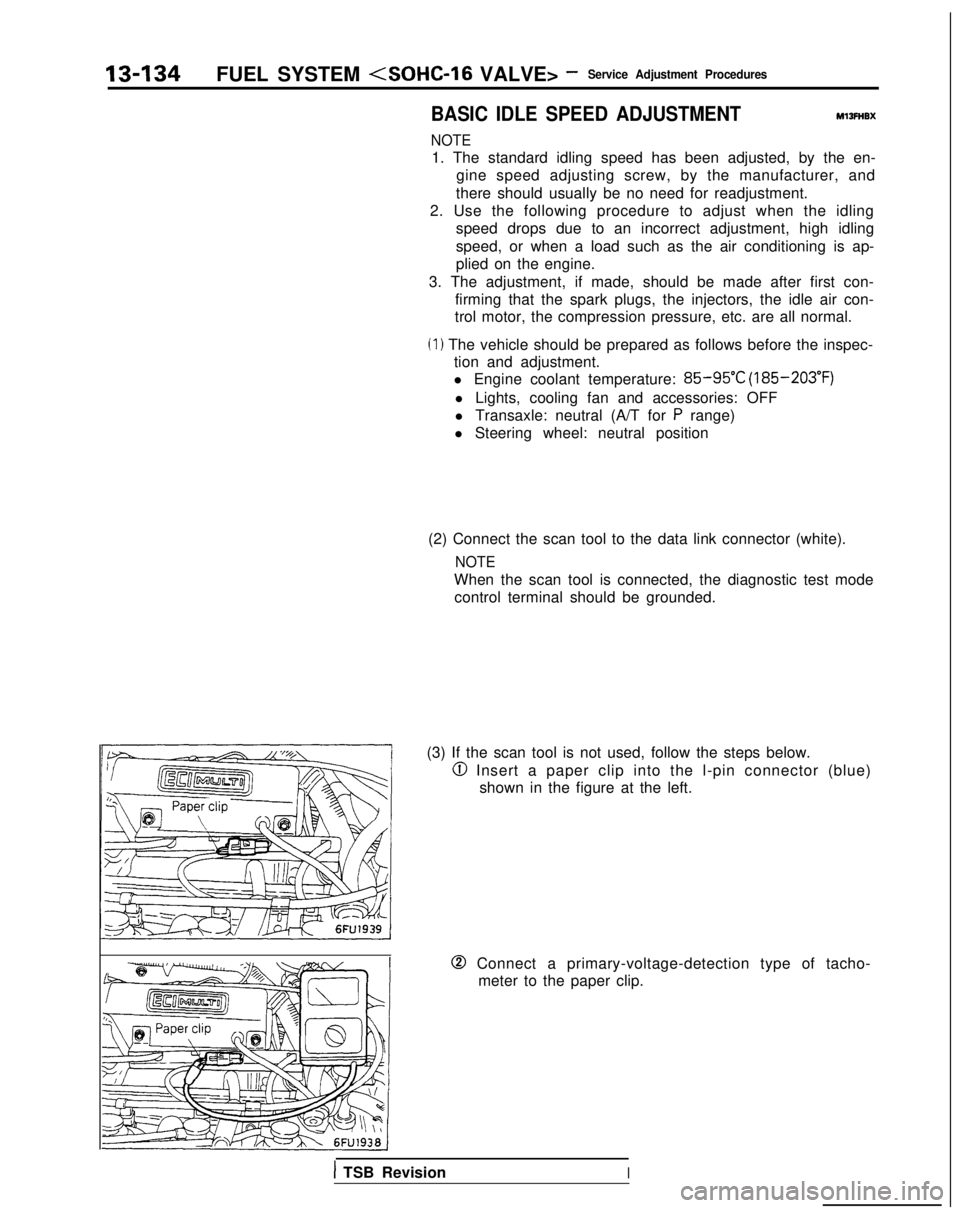
13-134FUEL SYSTEM (SOHC-16 VALVE> -Service Adjustment Procedures
BASIC IDLE SPEED ADJUSTMENTMlIFHBX
NOTE
1. The standard idling speed has been adjusted, by the en-
gine speed adjusting screw, by the manufacturer, and
there should usually be no need for readjustment.
2. Use the following procedure to adjust when the idling speed drops due to an incorrect adjustment, high idling
speed, or when a load such as the air conditioning is ap-
plied on the engine.
3. The adjustment, if made, should be made after first con- firming that the spark plugs, the injectors, the idle air con-
trol motor, the compression pressure, etc. are all normal.
(I ) The vehicle should be prepared as follows before the inspec- tion and adjustment.
l Engine coolant temperature:
85-95°C (185-203°F)
l Lights, cooling fan and accessories: OFF
l Transaxle: neutral (A/T for
P range)
l Steering wheel: neutral position
(2) Connect the scan tool to the data link connector (white).
NOTE
When the scan tool is connected, the diagnostic test mode control terminal should be grounded.
(3) If the scan tool is not used, follow the steps below.
@I Insert a paper clip into the l-pin connector (blue) shown in the figure at the left.
0 Connect a primary-voltage-detection type of tacho-meter to the paper clip.
1 TSB RevisionI
Page 277 of 1273
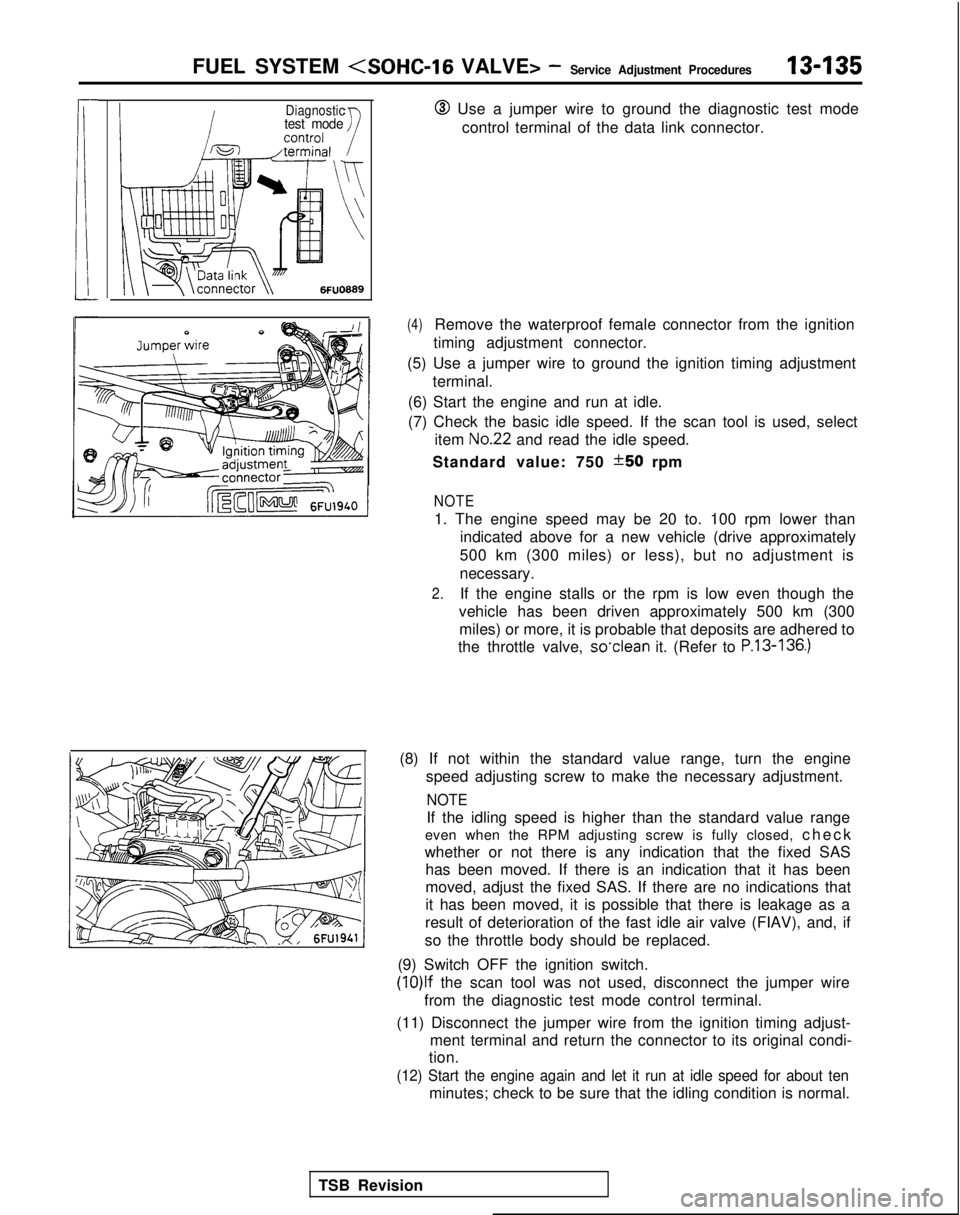
FUEL SYSTEM
Diagnostictest mode@ Use a jumper wire to ground the diagnostic test mode
control terminal of the data link connector.
TSB Revision
(4)Remove the waterproof female connector from the ignition
timing adjustment connector.
(5) Use a jumper wire to ground the ignition timing adjustment terminal.
(6) Start the engine and run at idle.
(7) Check the basic idle speed. If the scan tool is used, select item
No.22 and read the idle speed.
Standard value: 750
*50 rpm
NOTE
1. The engine speed may be 20 to. 100 rpm lower than indicated above for a new vehicle (drive approximately
500 km (300 miles) or less), but no adjustment is
necessary.
2.If the engine stalls or the rpm is low even though the
vehicle has been driven approximately 500 km (300 miles) or more, it is probable that deposits are adhered to
the throttle valve, so’clean
it. (Refer to
P.13-136.)
(8) If not within the standard value range, turn the engine
speed adjusting screw to make the necessary adjustment.
NOTE
If the idling speed is higher than the standard value range
even when the RPM adjusting screw is fully closed, chec
k
whether or not there is any indication that the fixed SAS has been moved. If there is an indication that it has been
moved, adjust the fixed SAS. If there are no indications that
it has been moved, it is possible that there is leakage as a
result of deterioration of the fast idle air valve (FIAV), and, if
so the throttle body should be replaced.
(9) Switch OFF the ignition switch. (lO)lf
the scan tool was not used, disconnect the jumper wire
from the diagnostic test mode control terminal.
(11) Disconnect the jumper wire from the ignition timing adjust- ment terminal and return the connector to its original condi-
tion.
(12) Start the engine again and let it run at idle speed for about ten\
minutes; check to be sure that the idling condition is normal.
Page 278 of 1273
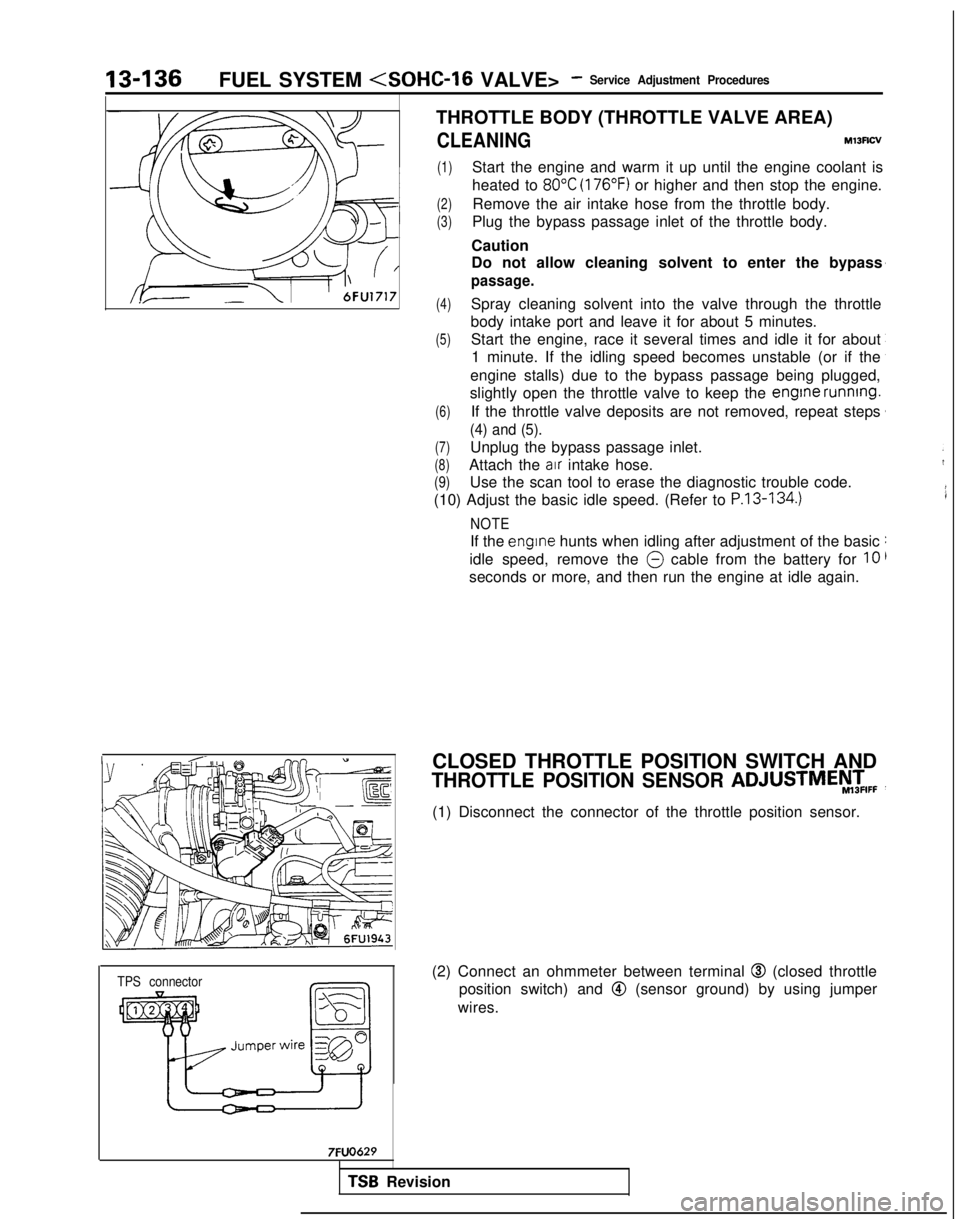
13-136FUEL SYSTEM
TPS connector
7FUO629
THROTTLE BODY (THROTTLE VALVE AREA)
CLEANINGMl3Rcv
(1)Start the engine and warm it up until the engine coolant is
heated to
80°C (176°F) or higher and then stop the engine.
(2)Remove the air intake hose from the throttle body.
(3)Plug the bypass passage inlet of the throttle body.
Caution
Do not allow cleaning solvent to enter the bypass
passage.
(4)Spray cleaning solvent into the valve through the throttle
body intake port and leave it for about 5 minutes.
(5)Start the engine, race it several times and idle it for about 1 minute. If the idling speed becomes unstable (or if the
engine stalls) due to the bypass passage being plugged,
slightly open the throttle valve to keep the engine
running.
(6)If the throttle valve deposits are not removed, repeat steps
(4) and (5).
(7)Unplug the bypass passage inlet.
(8)Attach the air intake hose.
(9)Use the scan tool to erase the diagnostic trouble code.
(10) Adjust the basic idle speed. (Refer to
P.13-134.)
NOTE
If the engrne hunts when idling after adjustment of the basic
idle speed, remove the
@ cable from the battery for 10
seconds or more, and then run the engine at idle again.
CLOSED THROTTLE POSITION SWITCH AND
THROTTLE POSITION SENSOR ADJUSTMEy,zIFF
(1) Disconnect the connector of the throttle position sensor.
(2) Connect an ohmmeter between terminal
@I (closed throttle
position switch) and
@ (sensor ground) by using jumper
wires.
TSB Revision
Page 279 of 1273
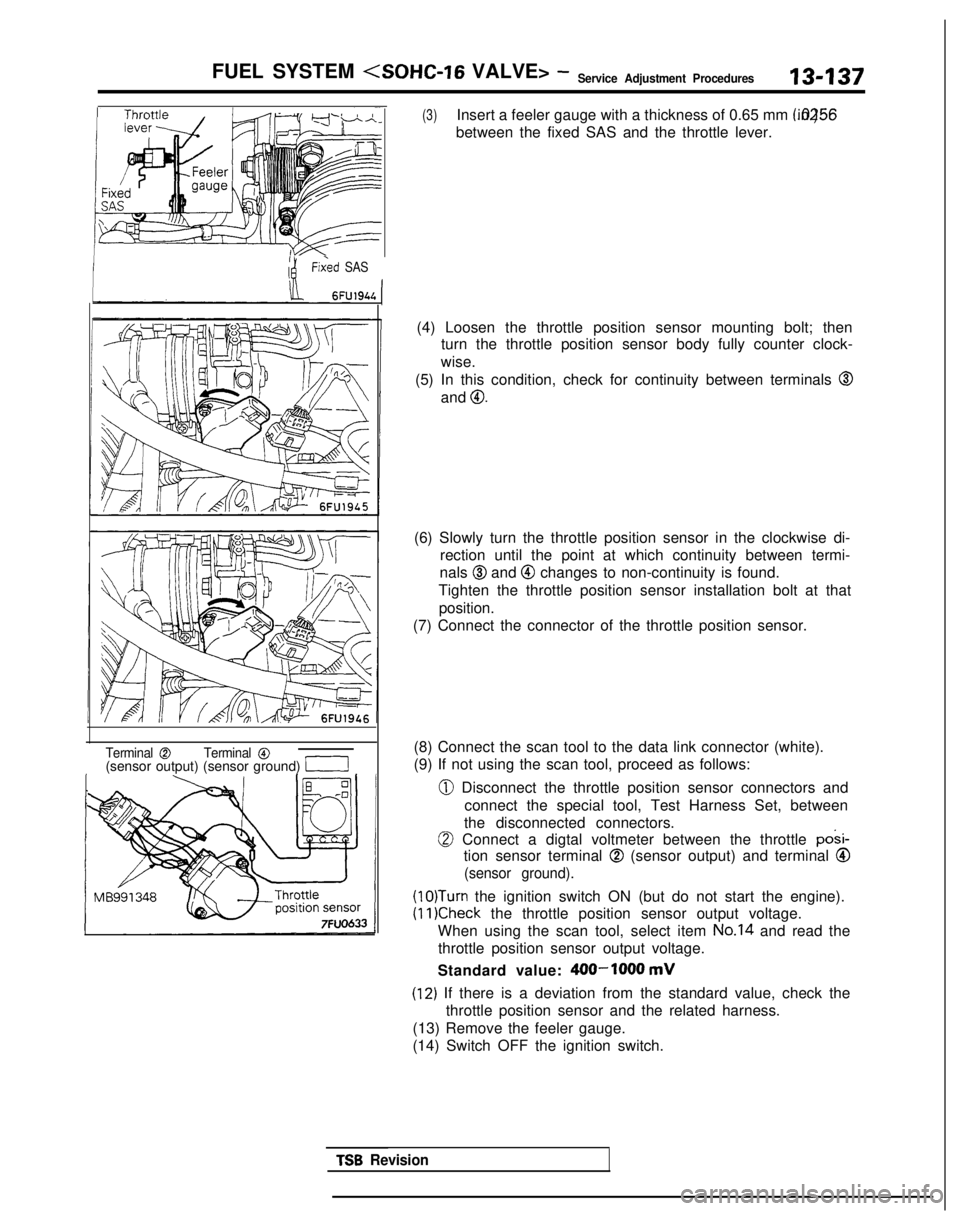
FUEL SYSTEM
I;gFixed SAS
Terminal @Terminal @(sensor output) (sensor ground) /
(3)Insert a feeler gauge with a thickness of 0.65 mm (.0256 in.)
between the fixed SAS and the throttle lever.
(4) Loosen the throttle position sensor mounting bolt; then turn the throttle position sensor body fully counter clock-
wise.
(5) In this condition, check for continuity between terminals
@
and 0.
(6) Slowly turn the throttle position sensor in the clockwise di- rection until the point at which continuity between termi-
nals
@I and @ changes to non-continuity is found.
Tighten the throttle position sensor installation bolt at that position.
(7) Connect the connector of the throttle position sensor.
(8) Connect the scan tool to the data link connector (white).
(9) If not using the scan tool, proceed as follows:
0 Disconnect the throttle position sensor connectors and connect the special tool, Test Harness Set, between
the disconnected connectors.
0 Connect a digtal voltmeter between the throttle posi-
tion sensor terminal
@ (sensor output) and terminal Q
(sensor ground).
(lO)Turn the ignition switch ON (but do not start the engine).
(11)Check the throttle position sensor output voltage.
When using the scan tool, select item
No.14 and read the
throttle position sensor output voltage.
Standard value:
400-1000 mV
(12) If there is a deviation from the standard value, check the throttle position sensor and the related harness.
(13) Remove the feeler gauge.
(14) Switch OFF the ignition switch.
TSB Revision
Page 280 of 1273
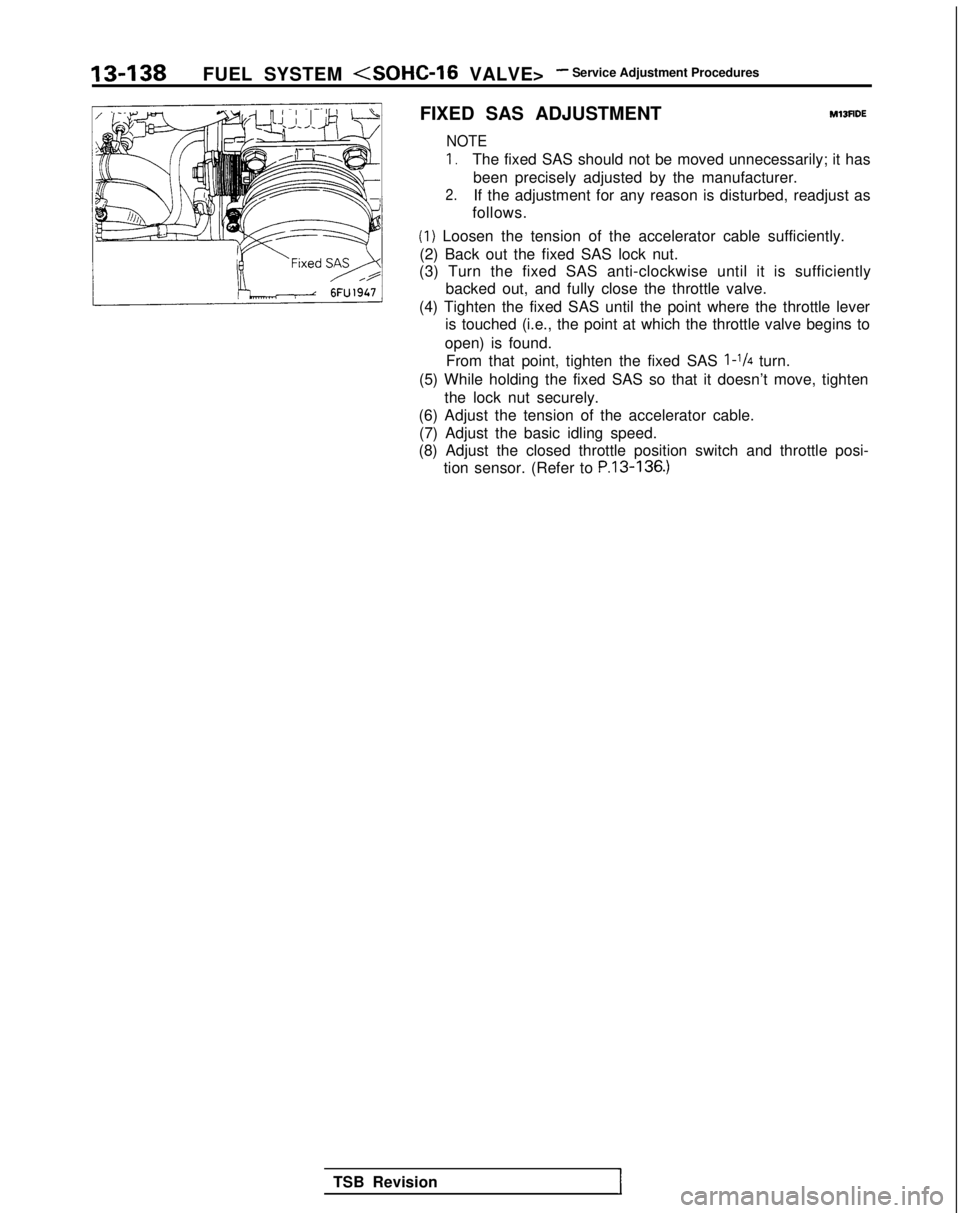
13-138
FUEL SYSTEM (SOHC-16 VALVE>- Service Adjustment Procedures
FIXED SAS ADJUSTMENT
M13FlDE
NOTE
I,The fixed SAS should not be moved unnecessarily; it has been precisely adjusted by the manufacturer.
2.If the adjustment for any reason is disturbed, readjust as
follows.
(1) Loosen the tension of the accelerator cable sufficiently.
(2) Back out the fixed SAS lock nut.
(3) Turn the fixed SAS anti-clockwise until it is sufficiently
backed out, and fully close the throttle valve.
(4) Tighten the fixed SAS until the point where the throttle lever is touched (i.e., the point at which the throttle valve begins to
open) is found. From that point, tighten the fixed SAS
l-1/4 turn.
(5) While holding the fixed SAS so that it doesn’t move, tighten the lock nut securely.
(6) Adjust the tension of the accelerator cable. (7) Adjust the basic idling speed.
(8) Adjust the closed throttle position switch and throttle posi- tion sensor. (Refer to
P.13-136.)
TSB RevisionI